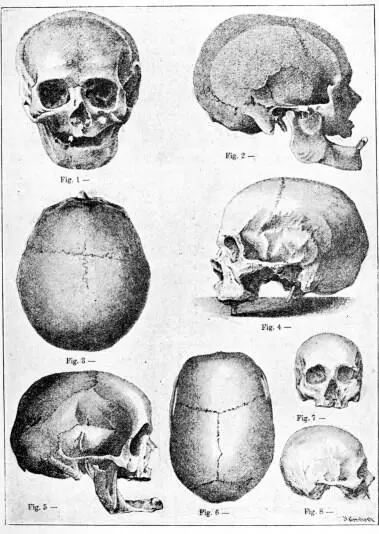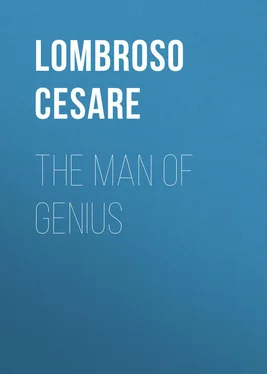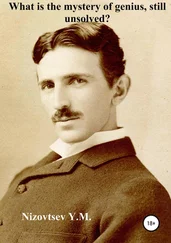Cesare Lombroso - The Man of Genius
Здесь есть возможность читать онлайн «Cesare Lombroso - The Man of Genius» — ознакомительный отрывок электронной книги совершенно бесплатно, а после прочтения отрывка купить полную версию. В некоторых случаях можно слушать аудио, скачать через торрент в формате fb2 и присутствует краткое содержание. Жанр: foreign_antique, foreign_prose, на английском языке. Описание произведения, (предисловие) а так же отзывы посетителей доступны на портале библиотеки ЛибКат.
- Название:The Man of Genius
- Автор:
- Жанр:
- Год:неизвестен
- ISBN:нет данных
- Рейтинг книги:5 / 5. Голосов: 1
-
Избранное:Добавить в избранное
- Отзывы:
-
Ваша оценка:
- 100
- 1
- 2
- 3
- 4
- 5
The Man of Genius: краткое содержание, описание и аннотация
Предлагаем к чтению аннотацию, описание, краткое содержание или предисловие (зависит от того, что написал сам автор книги «The Man of Genius»). Если вы не нашли необходимую информацию о книге — напишите в комментариях, мы постараемся отыскать её.
The Man of Genius — читать онлайн ознакомительный отрывок
Ниже представлен текст книги, разбитый по страницам. Система сохранения места последней прочитанной страницы, позволяет с удобством читать онлайн бесплатно книгу «The Man of Genius», без необходимости каждый раз заново искать на чём Вы остановились. Поставьте закладку, и сможете в любой момент перейти на страницу, на которой закончили чтение.
Интервал:
Закладка:
Without doubt many alienists have here fallen into exaggerations, especially when they have sought to deduce degeneration from a single fact. But, taken on the whole, the theory is irrefutable; every day brings fresh applications and confirmations. Among the most curious are those supplied by recent studies on genius. The signs of degeneration in men of genius they show are sometimes more numerous than in the insane. Let us examine them.
Height. – First of all it is necessary to remark the frequency of physical signs of degeneration, only masqued by the vivacity of the countenance and the prestige of reputation, which distracts us from giving them due importance.
The simplest of these, which struck our ancestors and has passed into a proverb, is the smallness of the body.
Famous for short stature as well as for genius were: Horace ( lepidissimum homunculum dicebat Augustus ), Philopœmen, Narses, Alexander ( Magnus Alexander corpore parvus erat ), Aristotle, Plato, Epicurus, Chrysippus, Laertes, Archimedes, Diogenes, Attila, Epictetus, who was accustomed to say, “Who am I? A little man.” Among moderns one may name, Erasmus, Socinus, Linnæus, Lipsius, Gibbon, Spinoza, Haüy, Montaigne, Mezeray, Lalande, Gray, John Hunter (5ft. 2in.), Mozart, Beethoven, Goldsmith, Hogarth, Thomas Moore, Thomas Campbell, Wilberforce, Heine, Meissonnier, Charles Lamb, Beccaria, Maria Edgeworth, Balzac, De Quincey, William Blake (who was scarcely five feet in height), Browning, Ibsen, George Eliot, Thiers, Mrs. Browning, Louis Blanc, Mendelssohn, Swinburne, Van Does (called the Drum, because he was not any taller than a drum), Peter van Laer (called the Puppet). Lulli, Pomponazzi, Baldini, were very short; so also were Nicholas Piccinini, the philosopher Dati, and Baldo, who replied to the sarcasm of Bartholo, “ Minuit præsentia fama ,” with the words, “ Augebit cætera virtus ;” and again, Marsilio Ficino, of whom it was said, “ Vix ad lumbos viri stabat .” Albertus Magnus was of such small size that the Pope, having allowed him to kiss his foot, commanded him to stand up, under the impression that he was still kneeling. When the coffin of St. Francis Xavier was opened at Goa in 1890, the body was found to be only four and a half feet in length.
Among great men of tall stature I only know Volta, Goethe, Petrarch, Schiller, D’Azeglio, Helmholtz, Foscolo, Charlemagne, Bismarck, Moltke, Monti, Mirabeau, Dumas père , Schopenhauer, Lamartine, Voltaire, Peter the Great, Washington, Dr. Johnson, Sterne, Arago, Flaubert, Carlyle, Tourgueneff, Tennyson, Whitman.
Rickets. – Agesilaus, Tyrtæus, Æsop, Giotto, Aristomenes, Crates, Galba, Brunelleschi, Magliabecchi, Parini, Scarron, Pope, Leopardi, Talleyrand, Scott, Owen, Gibbon, Byron, Dati, Baldini, Moses Mendelssohn, Flaxman, Hooke, were all either rachitic, lame, hunch-backed, or club-footed.
Pallor. – This has been called the colour of great men; “ Pulchrum sublimium virorum florem ” (S. Gregory, Orationes XIV. ). It was ascertained by Marro 12 12 I Caratteri dei Delinquenti , 1886, Turin.
that this is one of the most frequent signs of degeneration in the morally insane.
Emaciation. – The law of the conservation of energy which rules the whole organic world, explains to us other frequent abnormalities, such as precocious greyness and baldness, leanness of the body, and weakness of sexual and muscular activity, which characterize the insane, and are also frequently found among great thinkers. Lecamus 13 13 Méd. de l’Esprit , ii.
has said that the greatest geniuses have the slenderest bodies. Cæsar feared the lean face of Cassius. Demosthenes, Aristotle, Cicero, Giotto, St. Bernard, Erasmus, Salmasius, Kepler, Sterne, Walter Scott, John Howard, D’Alembert, Fénelon, Boileau, Milton, Pascal, Napoleon, were all extremely thin in the flower of their age.
Others were weak and sickly in childhood; such were Demosthenes, Bacon, Descartes, Newton, Locke, Adam Smith, Boyle, Pope, Flaxman, Nelson, Haller, Körner, Pascal, Wren, Alfieri, Renan.
Ségur wrote of Voltaire that his leanness recalled his labours, and that his slight bent body was only a thin, transparent veil, through which one seemed to see his soul and genius. Lamennais was “a small, almost imperceptible man, or rather a flame chased from one point of the room to the other by the breath of his own restlessness.” 14 14 Lamartine, Cours de Littérature , ii.
Physiognomy. – Mind, a celebrated painter of cats, had a cretin-like physiognomy. So also had Socrates, Skoda, Rembrandt, Dostoieffsky, Magliabecchi, Pope, Carlyle, Darwin, and, among modern Italians, Schiaparelli, who holds so high a rank in mathematics.
Cranium and Brain. – Lesions of the head and brain are very frequent among men of genius. The celebrated Australian novelist, Marcus Clarke, when a child, received a blow from a horse’s hoof which crushed his skull. 15 15 Revue Britannique , 1884.
The same is told of Vico, Gratry, Clement VI., Malebranche, and Cornelius, hence called a Lapide . The last three are said to have acquired their genius as a result of the accident, having been unintelligent before. Mention should also be made of the parietal fracture in Fusinieri’s skull; 16 16 Canesterini, Il Cranio di Fusinieri , 1875.
of the cranial asymmetry of Pericles, who was on this account surnamed Squill-head (σκινοκἑφαλος) by the Greek comic writers 17 17 Plutarch, Life of Pericles , iii.
; of Romagnosi, of Bichat, of Kant, 18 18 Kupfer, “Der Schädel Kants,” in Arch. für Anth. , 1881.
of Chenevix, 19 19 Welcker, Schiller’s Schädel , 1883.
of Dante, who presented an abnormal development of the left parietal bone, and two osteomata on the frontal bone; the plagiocephaly of Brunacci and of Machiavelli; the extreme prognathism of Foscolo (68°) and his low cephalic-spinal and cephalic-orbital index; 20 20 Mantegazza, Sul Cranio di Foscolo , Florence, 1880.
the ultra-dolichocephaly of Fusinieri (index 74), contrasting with the ultra-brachycephaly which is characteristic of the Venetians (82 to 84); the Neanderthaloid skull of Robert Bruce; 21 21 Turner, Quarterly Journal of Science , 1864.
of Kay Lye, 22 22 De Quatrefages, Crania Ethnica , Part i. p. 30.
of San Marsay (index 69), and the ultra-dolichocephaly of O’Connell (index 73), which contrasts with the mesocephaly of the Irish; the median occipital fossa of Scarpa; 23 23 Zoja, La Testa di Scarpa , 1880.
the transverse occipital suture of Kant, his ultra-brachycephaly (88·5), platycephaly (index of height 71·1), the disproportion between the superior portion of his occipital bone, more developed by half, and the inferior or cerebellar portion. It is the same with the smallness of the frontal arch compared to the parietal.

Figs. 1-3. Kant’s Skull.
“ 4. Volta’s Skull.
Figs. 5-6. Fusinieri’s Skull.
“ 7-8. Foscolo’s Skull.
In Volta’s skull 24 24 Sul Cranio di Volta , 1879, Turin.
I have noted several characters which anthropologists consider to belong to the lower races, such as prominence of the styloid apophyses, simplicity of the coronal suture, traces of the median frontal suture, obtuse facial angle (73°), but especially the remarkable cranial sclerosis, which at places attains a thickness of 16 millemetres; hence the great weight of the skull (753 grammes).
Интервал:
Закладка:
Похожие книги на «The Man of Genius»
Представляем Вашему вниманию похожие книги на «The Man of Genius» списком для выбора. Мы отобрали схожую по названию и смыслу литературу в надежде предоставить читателям больше вариантов отыскать новые, интересные, ещё непрочитанные произведения.
Обсуждение, отзывы о книге «The Man of Genius» и просто собственные мнения читателей. Оставьте ваши комментарии, напишите, что Вы думаете о произведении, его смысле или главных героях. Укажите что конкретно понравилось, а что нет, и почему Вы так считаете.












